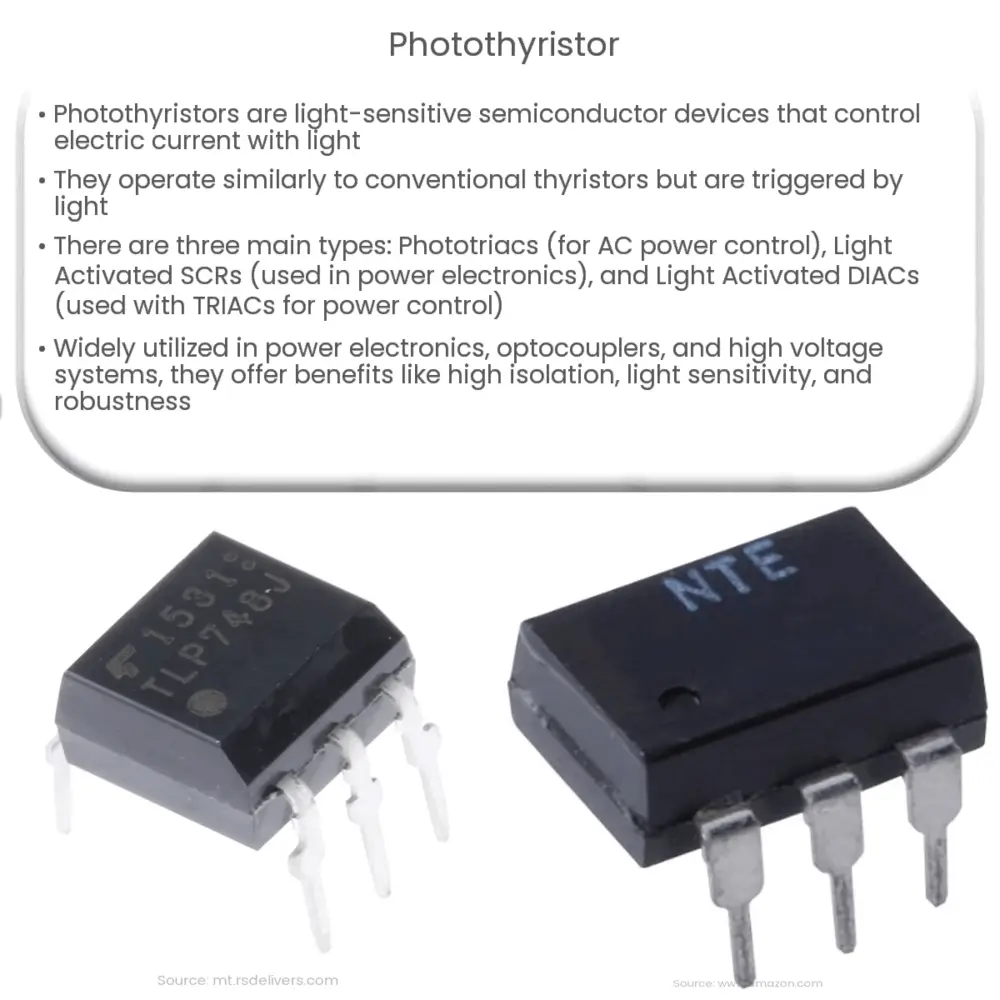Explore the world of photothyristors – their types, working principle, applications, and benefits in modern electronics.

Introduction to Photothyristors
A photothyristor is a light-sensitive semiconductor device that controls electric current flow with light. It is a kind of phototransistor that belongs to the thyristor family. The photothyristor is activated or turned on by light and turned off by reducing the current flow below the holding current.
Working Principle of Photothyristors
The operation of a photothyristor is similar to a conventional thyristor, except for the triggering method. The triggering of a thyristor is done through the gate terminal, but in a photothyristor, it’s done through light. The photothyristor has two states, the ‘off’ state and the ‘on’ state. It remains in the ‘off’ state until light is applied, and once exposed to light, it goes to the ‘on’ state.
- Off State: In the absence of light, the photothyristor stays in high-impedance, non-conductive state.
- On State: When light falls on the device, it goes into a low-impedance, conductive state. This state continues even after the removal of light, until the current is reduced below the holding current.
Types of Photothyristors
There are three main types of photothyristors, namely:
- Phototriacs: These are essentially triacs triggered by light. They are used for AC power control.
- Light Activated Silicon Controlled Rectifiers (LASCRs): These are SCR devices triggered by light, commonly used in power electronic devices.
- Light Activated DIACs (LADs): These are DIAC devices triggered by light, often used in conjunction with TRIACs for power control.
These types of photothyristors are distinguished based on their structure and functionality. Each has its unique advantages and applications, which we will explore in detail in the next sections.
Applications of Photothyristors
Photothyristors are widely used in various applications due to their high sensitivity to light, compact size, and low power consumption. Some of the key applications include:
- Power electronics and AC power control
- Light detection and coupling in optocouplers
- Isolation and control in high voltage systems
We will delve deeper into these applications and the benefits of photothyristors in our following discussion.
Delving Deeper into Photothyristor Applications
Let’s explore the applications of photothyristors in more detail:
- Power Electronics and AC Power Control: Photothyristors, particularly phototriacs, are extensively used in power electronics and AC power control. They help control power to electrical appliances, adjusting the amount of current flowing through the circuit based on the light intensity. This finds utility in light dimming applications, speed control in AC motors, and switching inductive loads.
- Light Detection and Coupling in Optocouplers: Optocouplers, also known as opto-isolators, use a photothyristor to achieve electrical isolation. When an electrical signal is applied to the LED within the optocoupler, it emits light, which triggers the photothyristor into its ‘on’ state, thus transmitting the signal while maintaining electrical isolation.
- Isolation and Control in High Voltage Systems: High voltage systems require devices capable of handling high current and voltage levels while providing good isolation. Light Activated Silicon Controlled Rectifiers (LASCRs) are often used in such systems due to their high voltage and current capabilities and ability to be triggered by light, which provides excellent isolation.
Benefits of Photothyristors
Photothyristors offer several significant benefits:
- They provide a high degree of isolation, beneficial in high voltage applications.
- Their light sensitivity allows for easy control without physical connection, useful in applications requiring electrical isolation.
- They can handle high voltage and current, making them suitable for power electronics.
- Photothyristors are robust, reliable, and have a long operational life.
Conclusion
In conclusion, photothyristors play a vital role in many areas of electronics and electrical engineering, particularly in power electronics and optoelectronics. Their ability to switch states based on light intensity allows them to control current flow efficiently in various applications, ranging from AC power control to high voltage systems. The unique advantages they offer, such as high isolation, light sensitivity, and ability to handle high voltage and current, make them an invaluable tool in modern electronics. As technology continues to evolve, the use of photothyristors is expected to expand further, leading to new applications and advancements in the field.

